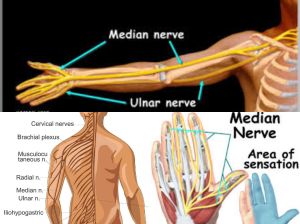Where you are hurting is not the problem. Where you hurt is the symptom.
If you stop reading early, the next two lines are what you need know:
Pain is part of predictive cycle that something is wrong. As uncomfortable as pain may be, pain is a signal telling you to put the brakes on whatever may be provoking you.
Here are the fact’s:
What is carpal tunnel.
Carpal tunnel is defined as a problem when you start feeling numbness, tingling, weakness, and other problems in your wrist. The typical response is to shake it to regain feeling and then head to the doctor. You will find out that for some reason there is too much pressure being placed on the median nerve in your wrist. He/she will tell you that is normal to lose the feeling the in your first four digits of your hand if you have carpal tunnel. I am not too sure that should make you comfortable or confident but what usually what follows is traditional muscular pain treatment advice.
- Stop activities that cause numbness and pain. (No kidding, but what if it is something you like to do)
- Ice your wrist for 10 to 15 minutes 1 or 2 times an hour. (that’s a lot of ice!)
- Take anti-inflamatories to relieve pain and reduce swelling. (Band-Aid, anyone?)
- Wear a wrist splint at night. (don’t forget to brush your teeth, too!)
Sorry for the sarcasm, but that really is sound advice to treat pain. Those are traditional methods to help you feel a little better. My issue is that I think most people are going to head to the doctor to end their problem, not just put it on the shelf for a little while.
Think Globally
One thing I left out is that the typical visit to the doctor for wrist pain complaints will include an examination of the wrist, and will also include an examination of your medical history. The problem is the examiner is usually trying to format a reason for why the patient’s complaint is a condition and trying to figure out why the patients history is contributing to the complaint.
What I am saying is that your body acts much like a ripple in a small pond. If you were to through a rock in the water, there will be a big splash at the point of impact and a ripple to the edge. This is how the body operates. If we injury our ankle, it changes how everything above it works.
AN EASY WAY TO FEEL THIS TO WEAR JUST ONE FOOT SHOE AND WALK AROUND. YOUR BODY WILL NEED TO A MAKE A SERIES OF ADJUSTMENTS TO KEEP YOU FROM FALLING OVER.
What is pretty neat is that our skeletal structure wont lie to us. With a careful eye, we can see just how much your history and habits are influencing joints being in the your body’s position and ultimately pain.
Carpal Tunnel as a Symptom of Malalignment
Lets remember how your body is telling that there is a problem. You feel a numbness or tingling in your wrist. Next, you are told that this is because there is too much pressure on the median nerve in your wrist.
That all makes perfect sense. The next logical question should be why does that pressure even exist? The answer could be a whole lot of things but usually it doesn’t involve the wrist.
When you look at the median nerve, you see that it travels from the shoulder to the end of the fingertips. It’s job is to take electrical impulses from the brain, through the arm and to the hand. The numbness and tingling occur when that message gets blocked somehow.
I think the easiest way to envision this is to think of a garden hose with a know in it. You turn the water on, it flows out, but because of the knot, it gets blocked and nothing comes out the nozzle. If you leave it like that, your grass will die.
My job is to essentially look for why the knot is occurring. I don’t diagnose a thing. Through assessment, I find the joints that are out of place and can contribute to pain.
When it comes to people who are suffering from pain and numbness in their fingers, I often find that they have postural distortion in their shoulders. Taking a look, that that images of the median nerve, this makes perfect sense. You will notice, that this giant nerve runs right across the front the shoulder and scapula. If the alignment of the arm, shoulder or shoulder-blade is distorted for any reason, than it can irritate the nerve and elicit a pain response.
“So what is controlling the swelling going to help?”
Controlling the swelling will help make you feel better for the moment but the problem is likely to keep recurring if we don’t address its root. Nobody should have to live in pain and nobody should accept the fact that all they can do is just “deal” with it.
“Well what do I do, then?”
First, let’s make sure we discover why you have a complaint. Lets look at your alignment from the front, back and the side to see just how your bones stack on top of each other.
We could easily start at your hand position and determine that your shoulder is rolling in. If we see this it could easily be used as a clue, that your shoulder-blade is popping up and your spine is bent. That could be the problem OR it could be that you are leaning to heavily on one leg and that pushing your opposite shoulder downward.
My point is not only that many things COULD be the cause of why you hurt but also that we CAN find them so you don’t have to just put a mask your problem.
Categories: weak link


Leave a comment